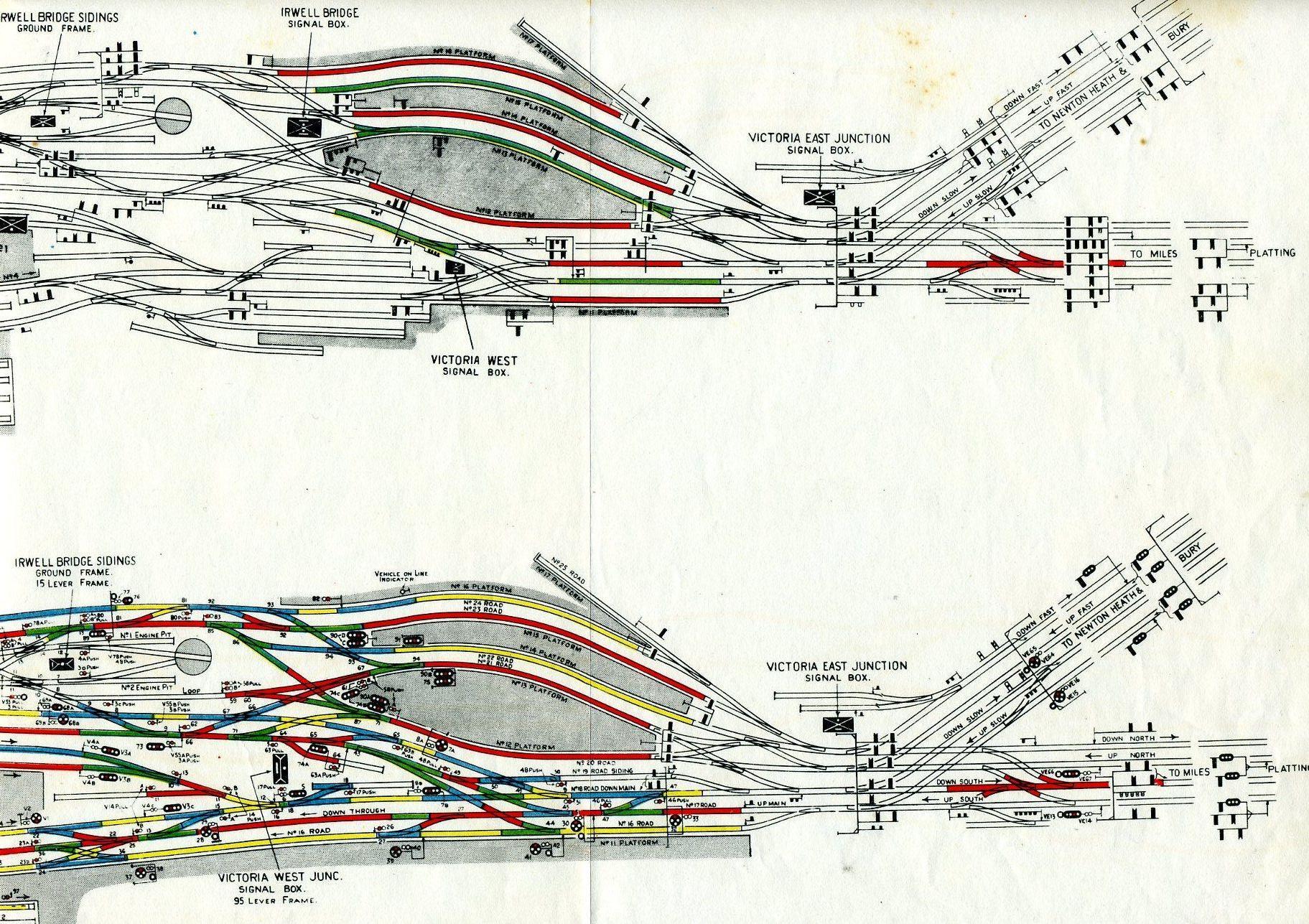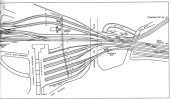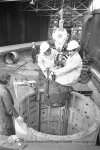Xenophon PCDGS
Veteran Member
What type of traffic was handled on this east-facing terminal platform?
My 1962 WTT shows DMU to Blackburn and to Colne. The 3L12 service.What type of traffic was handled on this east-facing terminal platform?

Platform 17 was on the opposite side of Manchester Victoria railway station to the ten east-facing terminal platforms that were under the main train shed. There were a number of through running lines that did not require platform usage for goods trains and passenger trains heading estwards from Manchester Exchange railway station in-between the very long platform 11 and platform 12, which had a sub-surface passenger connection to platforms 12 to 16.Is it worth noting that the diagrams miss out quite a large part of Manchester Victoria station.
What about the avoiding line through Red Bank that was discussed earlier in the thread?From those diagrams it looks like trains can't actually arrive at P17 (or 15 or 16) from the east, either before or after the 1928 re-signalling. So I guess it's most likely to have been for un/loading parcels vans that are dropped off by eastbound trains.
The photo of the panel in the link below isn't totally clear, but seems to indicate the same was true in 1976.
https://signalbox.org/branch-lines/a-day-to-remember/ (quote not relevant as I'm only referring to the diagram, but it's a good story if you need a digression).
I don't see any crossover that would allow trains to enter platform 17 from any of the four tracks that are signalled for trains to approach from the east, including the two from Red Bank. There are wrong-direction signals on the Down Fast (towards Red Bank) and the Down North (towards Miles Platting), and probably also on the Down South, that would allow trains to reverse into platform 17.What about the avoiding line through Red Bank that was discussed earlier in the thread?
This topic came up around 10 years ago in a thread regarding 'old' Manchester Victoria.What type of traffic was handled on this east-facing terminal platform?
Springs Branch said:Trains Annual 1963 has an excellent 14-page article on Manchester Victoria & Exchange in the early 1960s (except it neglects to mention any of the interesting road access points brought up in this thread).
It states "Platform 17, a dead-end, is used for parcels traffic exclusively, except for one Friday night passenger train to Todmorden for about two months in the summer".

I travelled on many of those services in the late 50's and early 60's. It brought back quite a few memories. That parcels train took quite an usual route past Red Bank, through Radcliffe and then to Bradley Fold and Bolton, parts of the route I never travelled on.My 1962 WTT shows DMU to Blackburn and to Colne. The 3L12 service.
I'm glad it brought back some of those memories!I travelled on many of those services in the late 50's and early 60's. It brought back quite a few memories. That parcels train took quite an usual route past Red Bank, through Radcliffe and then to Bradley Fold and Bolton, parts of the route I never travelled on.
Interesting that a Manchester - Accrington train train took 43 minutes, only 12 minutes faster than today following a shorter route.
I can't really comprehend the second sheet of the WTT without the station names included, but if it made intermediate stops it could have taken that route because they expected parcels for each of those calls, but not enough parcels to run separate trains. I wouldn't expect intermediate stations between Bury and Accrington to have much parcels traffic, and it could have been carried in the brake compartment of a passenger train.I'm glad it brought back some of those memories!
The unusual route the 3L12 took I think was down to two reasons:
1. The DMU configuration was a D1, so there were less power units pulling it.
2. To go the Bury - Accrington route you had to climb the 1 in 38 Baxenden bank.
The 1962 WTT shows it disappearing at Crumpsall, but it re-appears at Bolton Trinity for the line up to Darwen and Blackburn. Attached are pages F49 (Bolton to Blackburn) and F24 (Blackburn to Colne).
One interesting thing is that the 1962 WTT shows absolutely no parcels traffic at all on the route Accrington to Bury, so any parcels for East Lancs took a different route.
Yes, sorry about that, here is page F48 with the station names. My only reason for mentioning no parcels between Bury and Accrington was because it was the shorter route from Victoria to Colne instead of via Bolton and Blackburn.I can't really comprehend the second sheet of the WTT without the station names included
Ainsworth Road Halt was first stop after branching off at Radcliffe towards Bolton. Wasn't open all that long. Does look to have been served by one class only rail motors. Doubt that much traffic would have run from Manchester Victoria (platform 17 or otherwise) that actually called at Ainsworth Road. More at the below linked web page...Incidentally, was Ainsworth Road Halt on that junction line and was it only served by rail-motor services?
No trains ran on Sundays and all trains were one class only rail-motors.
Yes, it was on that line. There is information about the services at disused-stations.org . I remember my dad would commute to Manchester by catching a train from there to Radcliffe Central and then an electric to Victoria.Just wondering how many services from Manchester Victoria branched off at the junction at Radcliffe station to continue their journeys to the final destinations. Incidentally, was Ainsworth Road Halt on that junction line and was it only served by rail-motor services?
There would be no easy route for parcels from Crumpsall and Radcliffe in the Bolton, Blackburn direction apart from this train.I can't really comprehend the second sheet of the WTT without the station names included, but if it made intermediate stops it could have taken that route because they expected parcels for each of those calls, but not enough parcels to run separate trains. I wouldn't expect intermediate stations between Bury and Accrington to have much parcels traffic, and it could have been carried in the brake compartment of a passenger train.
That might be the reason for the routeing too, as an alternative to sending any such parcels into Victoria to be transferred onto another train there.There would be no easy route for parcels from Crumpsall and Radcliffe in the Bolton, Blackburn direction apart from this train.
I suspect what 'did for' the status of that Radcliffe - Bradley Fold (and on to Bolton) section was the L&YR's electrification of the Manchester - Bury line during WW1.Just wondering how many services from Manchester Victoria branched off at the junction at Radcliffe station to continue their journeys to the final destinations.

In my (voluntary) work at the Museum of Transport Greater Manchester, I have access to the museum’s archive including a lot of materials on Picc-Vic. It’s usually assumed that it never got beyond the drawing board but that’s not correct: the Market Street station box was built under the Arndale Centre and we have photos showing test bores being drilled on platform 1 at Victoria, and a shaft being dug on the site of the Fish Dock. I put one of the test drill photos on our Flickr feed shown below (click on the pic for larger version).I suspect what 'did for' the status of that Radcliffe - Bradley Fold (and on to Bolton) section was the L&YR's electrification of the Manchester - Bury line during WW1.
Summarising the Disused Stations entry:-
I've seen a photo of a steam-hauled excursion train whose origin was stated as Prestwich, so presumably Radcliffe - Bradley Fold was a useful shortcut to the seaside for specials from north Manchester suburbs, avoiding the congestion around Victoria.
- From the line's opening in 1879 until 1916, around a dozen through trains per day were provided between Manchester Victoria and Bolton Trinity St running via Prestwich.
- After 1916, the Manchester - Radcliffe - Bury line introduced frequent electric services and these became the main purpose of the line via Prestwich. Bolton - Radcliffe was relegated to a steam shuttle - although still running approximately hourly.
- In 1953 the regular Bolton - Radcliffe passenger service was withdrawn, and the station at Ainsworth Road closed.
- The Bradley Fold - Radcliffe line continued to be used by freight trains and passenger diversions (and the daily parcels train to Accrington) for another decade until it closed completely in November 1964.
Of course, if Manchester's 1970s Picc-Vic scheme had gone ahead as originally envisaged, there would have been plenty of trains branching off at the junction at Radcliffe.
This line would have been a component of the Bolton branch of the Picc-Vic's northern leg and would have been electrified with 25kV OHLE. Rolling stock was to have been Class 316 EMUs - Manchester versions of 1970s-era Class 314 & 315 units, and presumably operated on equivalent frequency to the Bury branch.
View attachment 152658
Back to the OT of platform usage at Victoria: I believe when the Picc-Vic tunnel was still on the drawing board, BR re-configured the layout of the low-numbered bay platforms at Victoria in anticipation.
Up until ~1973, only the far south-easterly bay platforms, nos. 1 & 2, were electrified for the Bury units. Oldham loop & Stalybridge DMUs generally left from the adjacent 3, 4 & 5, while 6 to 10 were used for parcels & stabling stock.
The local approach tracks from Collyhurst were reconfigured and the 1200V third rail was relocated to Platform 5 (and 4 for emergency use) and nos. 1 to 3 closed in anticipation that the new Picc-Vic tunnel would come up to the surface here, then join the existing alignment of the Bury line, as Metrolink does now. The new Victoria Low Level station platforms were meant to be underground, south of the main station and beneath Long Millgate.
Of course, this never happened, which left some handy waste ground for use as a car park. And there were other reasons for BR to do this rationalisation at the time - declining local traffic and the loss of services such as Bacup, Royton and Middleton meant there was no need for 10 bay platforms (plus a fish dock) at Victoria.
 Waiting for the train that never came by Museum of Transport Greater Manchester, on Flickr
Waiting for the train that never came by Museum of Transport Greater Manchester, on FlickrGreat capture of those solid citizens waiting for their Bury Electric unit to come cantering in!. . . photos showing test bores being drilled on platform 1 at Victoria, and a shaft being dug on the site of the Fish Dock.

The underground line wouldn't have surfaced at Victoria, it would have come up about a quarter mile to the east - presumably so it would go under the culvert that you mention. For a Brucie bonus, here's a photo in our collection of the shaft in the Fish Dock, with some distinctly nervous high-ups being lowered... But the reason for showing it is that it's one of VERY few photos taken showing the Fish Dock platform.Great capture of those solid citizens waiting for their Bury Electric unit to come cantering in!
Today, any test bore activity like that would not have the public nonchalantly waiting for their train right alongside the worksite. Probably would need to close the platforms completely for a week, cancel the whole Bury service and bring in the RRBs for the duration.
In the context of the Picc-Vic tunnel coming to the surface at Victoria, I had wondered about how close the proposed underground lines would have got to the River Irk culvert, which ran right beneath the eastern Bays part of the station.
It seems the river passed more-or-less underneath old platforms 4, 5 & 6 - so Picc-Vic should have been safe enough if it came in around the location of the Fish Dock and old nos. 1 & 2.
View attachment 152846
(Image shows platform layout at eastern end of Manchester Victoria, as at the early 1960s)
As I understand it (open to correction), the Irk Culvert now runs beneath the Metrolink platforms. And a separate reinforcing steel bridge structure had to be constructed over the top of the 19th-century culvert at the time the Metrolink station was expanded to three tracks, to safely cope with the weight of trams. (That project, along with installation of Victoria's 'bubble roof', was covered in several construction / civil engineering magazines and blogs).

